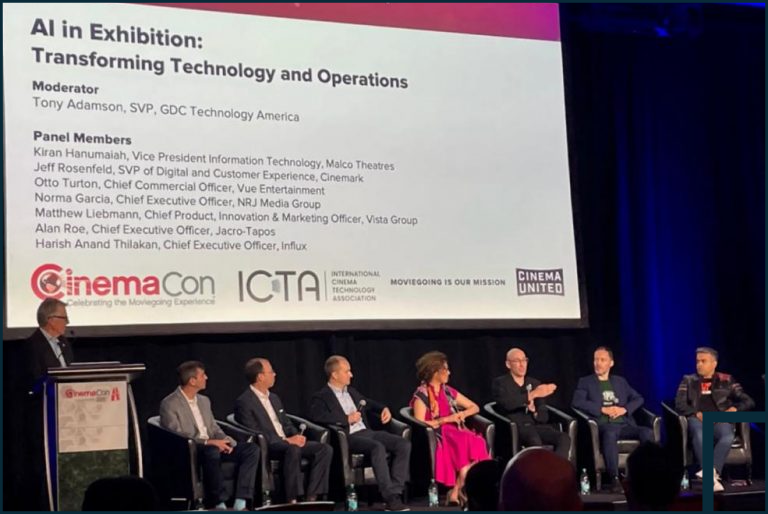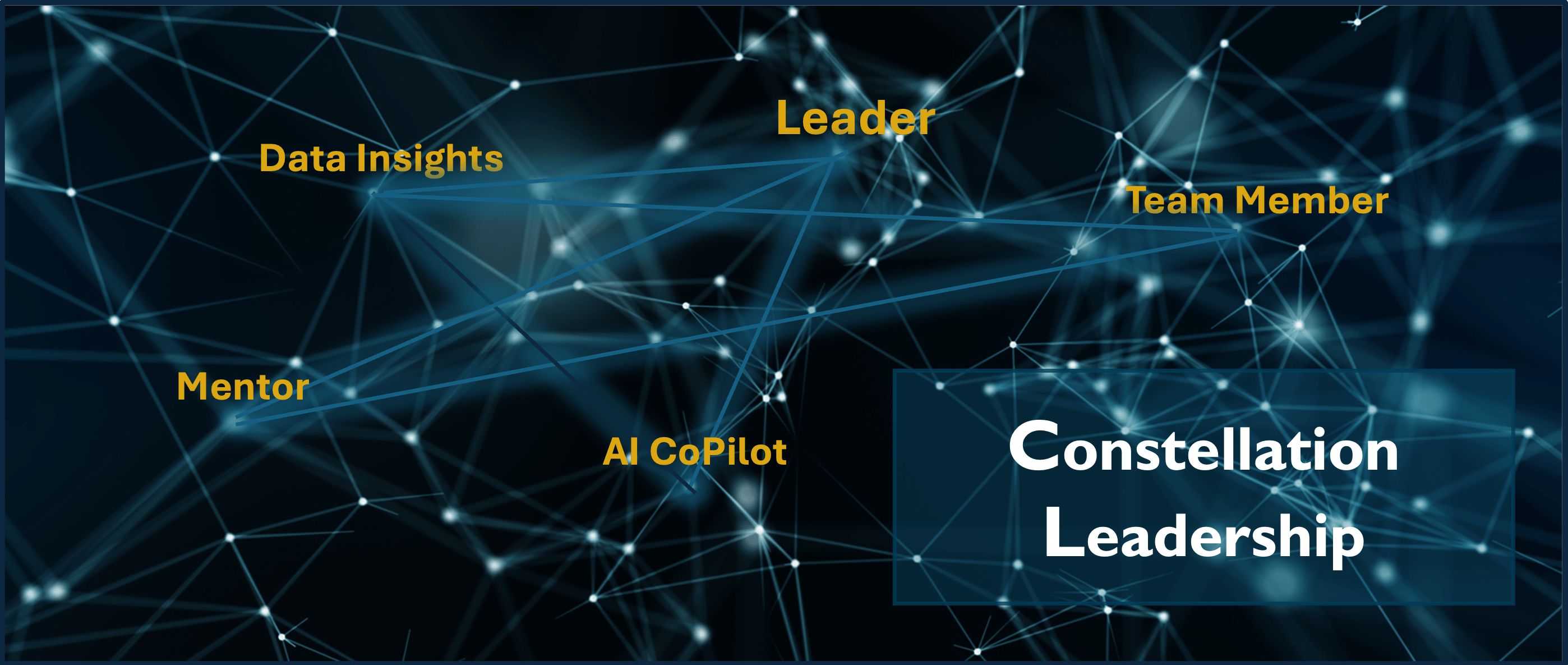
Leading Responsibly in the Age of AI:
Lessons from Stanford University
By Norma Garcia, Co-Founder & CEO of NRJ Media Group
“No, it’s necessary.” – Interstellar
In my 25+ years as an entertainment executive, I’ve worked across iconic brands like Star Wars, Indiana Jones, and Mission: Impossible, and championed technologies that redefined how we experience stories, including Dolby Atmos, high dynamic range (HDR), and luxury home media systems. I’ve seen firsthand how technology can elevate storytelling and how it can disrupt it. But nothing has captured my attention like the rise of artificial intelligence (AI). Not just as a tool, but as a transformative force.
Earlier this year, I enrolled in Stanford University’s AI-Driven Leadership program. My goal was clear: deepen my understanding of AI and co-lead NRJ Media Group and our podcast, Energis Podcast, into a future where creativity and human-centered technology can truly co-exist.
This article isn’t just a reflection. It’s a field guide for creators, leaders, and changemakers navigating the age of AI with responsibility and imagination.
ACT ONE: THE ORIGIN STORY – FROM EXPERIMENTER TO ADVOCATE
Before Stanford, my experience with AI came from experimentation. I used ChatGPT and Claude to brainstorm podcast titles, distill ideas, and stress-test messaging. It developed a rich contextual memory and became a powerful accelerator for clarity and output. I called it Robin, my tech-savvy sidekick.
I used generative AI to move faster, but Stanford helped me shift from playful use to strategic partnership. Now, I can focus my attention on high-level thinking and decision making.
We unpacked the STEP framework; Strategy, Technology, Execution, People, and its practical application across use cases. My mindset moved from “can we use this?” to “how do we guide it responsibly?”
The course gave me language, confidence, and clarity not just for how ethical AI fits into creative media, but how to lead by asking the most important question, what problems am I solving?
ACT TWO: SHIFTING THE NARRATIVE – FROM FEAR TO FLUENCY
In entertainment, AI often triggers anxiety: Will it replace us? Flatten originality? But fear is not a strategy. Stanford taught us to reframe these concerns through practical ethics and user-centered design.
We studied real-world failures like healthcare systems where AI models misread patient data due to lack of clinical context. The lesson? Ethical AI without human anchoring is a liability.
I saw parallels in media. Tools built without creative input risk tone-deafness. So at NRJ, I embedded AI tools into workflows with people, not around them.
It became clear: leading with transparency and purpose invites curiosity instead of resistance. The highest form of ignorance is rejecting something you don’t know. Educate yourself.
ACT THREE: AI IN ACTION – HOW NRJ MEDIA GROUP DID IT
Every Stanford module added to our playbook:
- Module 1 (Why AI Fails): Taught us that poor alignment causes failure. I revamped how we present AI making adoption feel intuitive and mission-aligned.
- Module 2 (Strategy + Change Management): Leadership isn’t about pushing tools. It’s about crafting narratives that invite participation. We began developing internal “micro teach” moments to boost literacy and inserted feedback loops by asking, “what are we learning?”
- Module 3 (Data Integrity): We audited and strengthened the quality of inputs from transcripts to metadata so AI didn’t compromise storytelling.
- Module 4 (Tool Selection): We curated tools with care (i.e. ChatGPT, Claude, Descript, Canva) each chosen for their creative compatibility, not just technical power, and we checked their output.
- Module 5 (Workflow Integration): I built modular content systems using AI to accelerate not override editorial decisions.
- Module 6 (Leadership Models): I envisioned flash teams, rotating editorial anchors, and values-driven delegation.

At NRJ Media Group, this translated into:
- An AI-powered content hub
- A podcast repurposing engine
- New editorial rituals like “Data Drama” and “Story Strategy Salons”
- SEO-optimized storytelling pipelines
Being invited to speak on an AI panel at CinemaCon 2025 by the International Cinema Technology Association (ICTA) was a full-circle moment. We weren’t just building; we were now shaping the conversation. Variety captured us on stage, spotlighting the shift from experimentation to influence.
(Because behind every AI system worth building, there’s still a human choice to lead with trust.)
ACT FOUR: EMOTIONAL INTELLIGENCE IS YOUR EDGE
You don’t need a data science degree to lead AI – mine is in marketing – you need emotional fluency. At NRJ, my co-founder and technical lead weren’t resistant; they were curious. But curiosity needs structure.
So, I became the translator breaking AI into actionable wins, aligning tools to outcomes, and ensuring the “why” never got lost in the “how.” My co-founder, Rich Reid, quickly picked up the knowledge and joined me in finding solutions to our challenges.
This is the job of a modern leader: to ask better questions, model vulnerability, and create safe space for iteration.
ACT FIVE: WHAT’S NEXT – CONSTELLATIONAL LEADERSHIP
One of my favorite reflections from Stanford was imagining a future workplace shaped not by rigid hierarchies, but by what I’m calling constellations. I believe the traditional hierarchical model is already giving way to something more fluid and purpose driven.

Imagine this:
Each team member is a bright node moving fluidly to where they create the most value. Managers become stewards of momentum, not bottlenecks. And AI agents? They’re copilots: surfacing insights, simulating outcomes, extending human capability.
I even coined a term: sponsibility, a blend of responsibility and sponsorship. Because it’s not just what we build with AI but why we build it, and who it serves.
To further future-proof our team structure and values, I’ve drawn inspiration from the military concept of decentralized command; a model that empowers individuals at every level to act autonomously, guided by a shared mission.
With the right training, data tools, and ethical frameworks, AI can become the invisible co-pilot helping streamline communication, surface relevant insights, and empower individuals to lead within their own spheres of ownership. This approach encourages creative freedom, avoids bottlenecks, and reinforces trust across departments.
When paired with AI, decentralized command becomes even more powerful: a living, values-driven system that honors both human intuition and technological augmentation.
ACT SIX: FROM STANFORD TO THE WORLD – IMPACT IN MOTION
This course wasn’t theoretical. It changed how I / we lead:
- We now confidently advise others on AI adoption.
- We’re building mentorship models for emerging creative leaders.
- We’re speaking on stages, getting interviewed, writing pieces like this, and weaving AI literacy into our podcast.
Dr. Melissa Valentine, a tenured Associate Professor in the Management Science and Engineering Department at Stanford University and Senior Fellow at Stanford Institute for Human-Centered AI, led the program. Her work sits at the intersection of artificial intelligence, organizational design, and the future of work. The case studies she curated were insightful and added depth to every assignment. Her lectures felt less like instruction and more like an invitation, sparking curiosity, collaboration, and a meaningful connection among students.
Throughout the course, I received detailed and encouraging feedback from our instructional lead, Ezequiel Astrada. His guidance helped me sharpen my vision and ground my work in both strategy and heart. Each assignment became a dialogue not just about what I built, but why it mattered. His reflections reminded me that leadership in AI isn’t just technical. It is personal, cultural, and deeply human.
FINAL FRAME: TEAM HUMAN, ALWAYS
Stanford gave me frameworks but more importantly, it gave me language for a future I already believe in. One where creators and engineers co-design, where ethics isn’t an afterthought, and where technology magnifies, not mutes, what makes us human. I want to help shape this future. One where more women and people from a broad range of perspectives are not only included, but empowered to lead as we design what comes next.
In the age of AI, let’s not lead from the top, but from the center. As the race for AI dominance accelerates around the world, let’s stay grounded in values, guided by intention, and yes, infuse a bit of cinematic flair.
Let’s lead the constellation.
About the Author
Norma Garcia is the Co-Founder & CEO of NRJ Media Group and co-host of the Energis Podcast. She is a member of the Television Academy of Arts & Sciences and a media and technology executive with 25+ years of experience spanning global entertainment, premium cinema, and innovation strategy. A former leader at Lucasfilm, Paramount Pictures, Dolby Laboratories, THX, and Kaleidescape, Norma now focuses on the intersection of ethical Al, storytelling, and leadership. She completed Stanford University’s Al-Driven Leadership program in 2025 and founded Women in Al Leadership, a global network inspired by her Stanford experience and dedicated to collaboration and responsible AI.
She continues to champion transformation and mentorship across creative and technological platforms.
Let’s connect: [LinkedIn] | [Energis Podcast]
